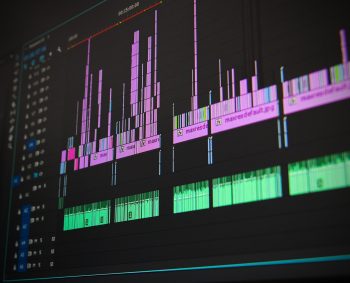
Podcast Editing Tips: 10 Common Mistakes (And How to Fix Them)
A great podcast isn’t just about good content, it’s about good audio. Listeners will forgive a minor slip-up, but if they’re straining to hear or become distracted by poor editing, they won’t stick around.
Podcast editing tips help ensure your episodes sound polished and professional. Here are 10 common mistakes and how to fix them.
1. Over-Editing the Conversation
One of the biggest mistakes beginners make is trying to edit out every single “um,” “ah,” or pause. While reducing unnecessary filler words can improve clarity, over-editing can make speech sound robotic or unnatural. Conversations should have a natural rhythm, and removing too much can strip away the personality of the speaker. The best podcast editing tip is to cut only when necessary… focus on removing real distractions while keeping the flow organic.
2. Ignoring Background Noise
Room tone, traffic outside, electrical hums. Background noise might seem minor during recording but can be a huge issue in post-production. A noise-free recording starts at the source: using a good microphone, recording in a quiet space, and positioning yourself correctly. While noise reduction tools can help, they should be used sparingly. Too much noise reduction can create a weird, artificial sound that’s just as distracting as the noise itself. Podcast editing tip: I suggest using high-quality noise reduction tools while ensuring you capture clean audio from the beginning, or check out my services and let me polish that podcast!
3. Bad Volume Balancing
One of the most common complaints from podcast listeners is volume inconsistency, when one speaker is significantly louder than another. Volume imbalances can force listeners to constantly adjust their volume. Using compression and normalisation helps smooth out levels so that everything sounds even. One of the best podcast editing tip is to use a limiter to keep everything within a comfortable range.

4. Choppy or Unnatural Edits
Listeners can tell when an edit is rough. If a cut is too abrupt, it becomes distracting. Good editing isn’t noticeable, it blends seamlessly. One trick is to use crossfades or to cut at natural breath points, so transitions feel more fluid. If a sentence has to be trimmed, listen to how it flows in context before finalising the cut. A key podcast editing tip: ALWAYS listen back before finalising edits!
5. Poor Use of Music and Sound Effects
Music and sound effects can enhance a podcast, but they need to be used correctly. Common mistakes include music that is too loud, doesn’t fade in or out properly, or doesn’t match the tone of the episode. Always check that music complements rather than overpowers speech, and use sound effects sparingly to avoid making the production feel cluttered.
6. Overlooking Room Tone
Room tone is the subtle sound of the recording environment, something many beginners forget to consider. If you record in multiple sessions or make heavy edits, mismatched room tone can make cuts stand out. A simple podcast editing tip is to record a few seconds of silence at the beginning of each recording session… this can later be used to smooth over edits and transitions.
7. Not Using EQ (Equalisation) Effectively
Every voice is different. Some microphones make voices sound too boomy, others too thin. EQ allows you to balance frequencies so voices sound clear and natural. A common podcast editing tip is to roll off low frequencies below 80Hz to remove unwanted rumble, slightly boost around 3-5kHz for clarity, and cut harsh frequencies around 2-4kHz if needed.
8. Skipping a Limiter
A limiter is a tool that prevents sudden spikes in volume. Without one, loud laughter, sharp intakes of breath, or even a strong ‘P’ sound can cause distortion. Setting a limiter correctly ensures that no part of the podcast audio clips while keeping everything within a comfortable listening range.
9. Relying Too Much on Automated Tools
AI-based tools like auto-ducking and automated noise reduction can be useful, but they shouldn’t replace manual adjustments. Many of these tools process audio in a way that can make it sound unnatural or introduce artefacts. One of the best podcast editing tips: Combine manual editing with automation for the best results.
10. Not Doing a Final Listen-Through Before Publishing
A lot of podcasters assume their episode is ready once editing is done, but skipping a final listen-through is a major mistake. This is the best way to catch awkward cuts, missing words, volume jumps, or glitches before they reach your audience. If you’re looking for podcast editing tips, always make time for a final quality check before release.
These Podcast Editing Tips Will Turn You Into A Pro
Podcast editing is about balance – removing distractions while keeping the authentic feel of the conversation intact. Whether you’re doing it yourself or hiring an editor, focusing on these details will result in a better listening experience. If you’d rather focus on creating content while someone else handles the tech, I can help take your production to the next level.


